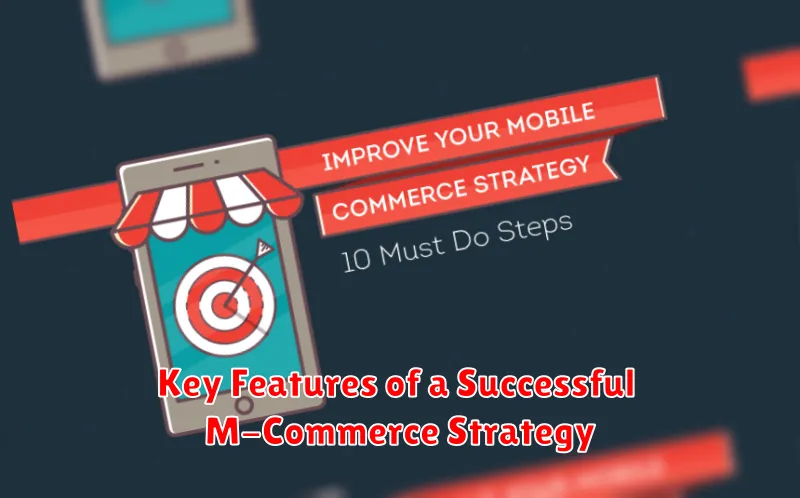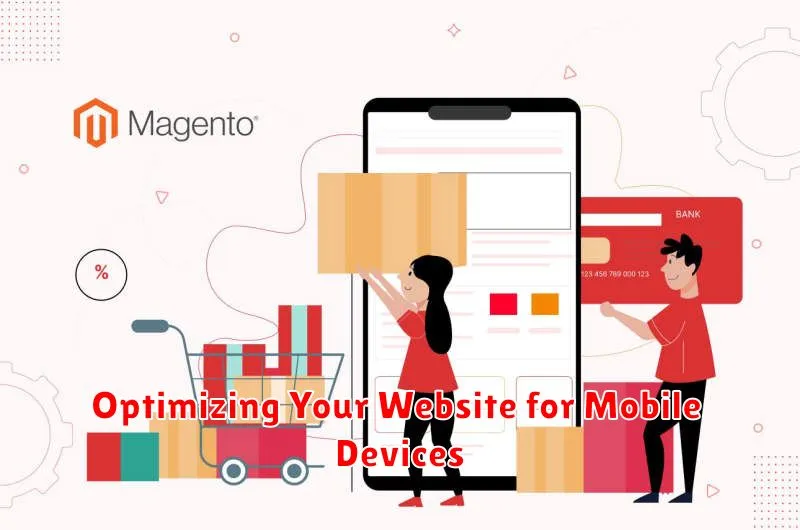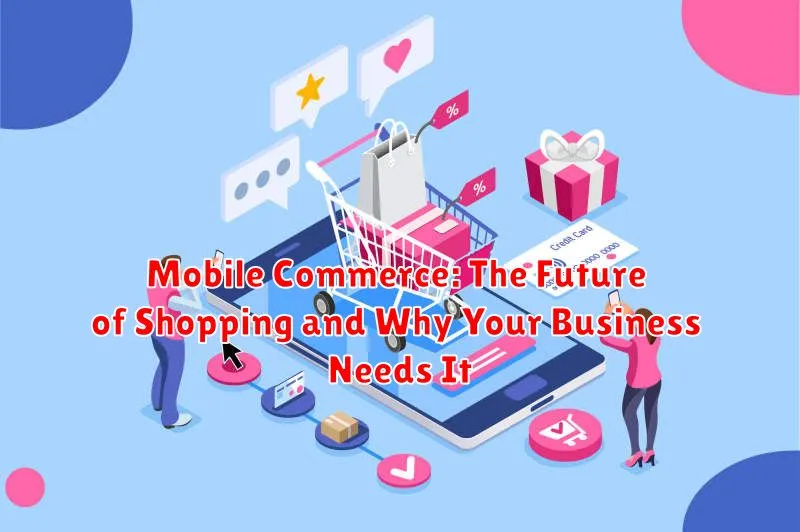Mobile commerce, also known as m-commerce, is rapidly transforming the e-commerce landscape. No longer a niche market, mobile shopping is now the dominant force, with consumers increasingly relying on their smartphones and tablets to browse, research, and purchase products and services. This shift towards mobile-first behavior presents both a challenge and an immense opportunity for businesses of all sizes. Understanding the power of m-commerce and adapting to this evolving market is crucial for staying competitive and reaching today’s mobile consumers. This article will explore the key trends driving the growth of mobile commerce and highlight the compelling reasons why your business needs to embrace this future of shopping.
From the convenience of in-app purchases to the rise of social commerce, mobile commerce offers unprecedented access to customers anytime, anywhere. This article will delve into the strategic advantages of incorporating m-commerce into your business strategy, including increased customer engagement, improved brand loyalty, and ultimately, higher revenue generation. Whether you are a small startup or a large enterprise, embracing the future of shopping through mobile commerce is no longer optional, but essential for sustained growth and success in the modern marketplace. Discover how mobile commerce can revolutionize your business and empower you to connect with customers in the dynamic and ever-expanding world of mobile shopping.
Understanding Mobile Commerce (M-Commerce)
Mobile commerce, or m-commerce, refers to the buying and selling of goods and services through wireless handheld devices such as smartphones and tablets. It encompasses a wide range of activities, including online shopping, mobile banking, and in-app purchases. M-commerce leverages the ubiquity of mobile devices to provide consumers with convenient access to products and services anytime, anywhere.
Unlike traditional e-commerce which relies on desktop computers, m-commerce optimizes the shopping experience for smaller screens and touch interfaces. This includes features like streamlined checkout processes and location-based services. The growth of m-commerce has been fueled by the increasing penetration of smartphones, faster internet speeds, and the development of sophisticated mobile applications.
Several factors distinguish m-commerce from traditional e-commerce. Mobility is key, enabling transactions on the go. Personalization is also enhanced through mobile devices, allowing businesses to target consumers based on their location and preferences. Finally, m-commerce often integrates seamlessly with other mobile functionalities like social media and mobile wallets.
The Importance of Mobile Commerce in Today’s Market
Mobile commerce has become indispensable in today’s rapidly evolving market. The sheer number of consumers using smartphones to browse and shop online has made m-commerce a critical channel for businesses to reach their target audience.
Consumers expect a seamless and convenient shopping experience, accessible anytime, anywhere. M-commerce fulfills this demand by providing instant access to products, services, and information. This ubiquitous availability influences purchasing decisions, making mobile a primary touchpoint in the customer journey.
Moreover, the rise of mobile payments and digital wallets further solidifies the importance of m-commerce. The ease and speed of transactions through mobile devices contributes to increased sales and customer satisfaction. Businesses that fail to embrace mobile commerce risk missing out on a substantial portion of the market and losing their competitive edge.
Benefits of M-Commerce for Businesses
Embracing m-commerce offers a multitude of advantages for businesses seeking growth and enhanced customer engagement. Increased reach is a key benefit, allowing businesses to connect with customers anytime, anywhere. This constant accessibility fosters stronger customer relationships and boosts brand loyalty.
Improved customer experience is another significant advantage. M-commerce platforms offer personalized shopping experiences, tailored recommendations, and streamlined checkout processes, enhancing customer satisfaction. This personalized approach leads to higher conversion rates and increased sales.
Reduced operational costs are also possible with m-commerce. By leveraging digital platforms, businesses can minimize expenses associated with physical stores and traditional marketing methods. This cost efficiency allows for greater flexibility and resource allocation.
Finally, m-commerce provides valuable data and insights into customer behavior. By analyzing mobile shopping patterns, businesses can better understand customer preferences and tailor their offerings accordingly. This data-driven approach facilitates targeted marketing campaigns and improved business strategies.
Key Features of a Successful M-Commerce Strategy

A successful m-commerce strategy hinges on several key features that create a seamless and engaging shopping experience for mobile users.
User-Friendly Interface: Prioritize a clean, intuitive interface designed for mobile screens. Easy navigation, clear product displays, and streamlined checkout processes are crucial for a positive user experience.
Secure Payment Gateway: Integrating secure and diverse payment options builds trust and encourages transactions. Offering mobile wallets, alongside traditional credit card options, caters to varying customer preferences.
Personalized Experience: Leverage data to personalize product recommendations and offers. Tailored content based on browsing history and purchase behavior enhances customer engagement and drives sales.
Omnichannel Integration: Create a consistent brand experience across all channels. Integrate your m-commerce platform with your website, social media, and physical stores to provide a unified shopping journey.
Performance Optimization: Ensure fast loading times and smooth performance. A slow and buggy mobile experience can lead to cart abandonment and negative reviews.
Mobile Commerce Trends to Watch
The m-commerce landscape is constantly evolving. Staying ahead of the curve requires businesses to understand and adapt to emerging trends. Here are some key mobile commerce trends to watch:
Augmented Reality (AR) Shopping Experiences
AR is transforming the way consumers interact with products online. By overlaying digital information onto the real world, AR allows customers to visualize products in their own environment before making a purchase, leading to increased customer satisfaction and reduced return rates.
The Rise of Social Commerce
Social media platforms are increasingly becoming transactional. Social commerce seamlessly integrates shopping experiences within social media apps, allowing users to discover and purchase products without leaving their preferred platform. This trend leverages the power of social influence and simplifies the buying process.
Voice Commerce and AI-Powered Personalization
Voice search and AI-driven personalization are changing how consumers discover and purchase products. Voice assistants enable hands-free shopping, while AI algorithms provide tailored product recommendations, creating a more convenient and personalized shopping experience.
Focus on Mobile-First Experiences
With the increasing dominance of mobile devices, businesses must prioritize mobile-first design. This means designing and optimizing websites and apps specifically for mobile devices to ensure a seamless and user-friendly experience.
Different Types of Mobile Commerce Apps
Businesses venturing into m-commerce can choose from various app types, each catering to specific needs and functionalities. Understanding these differences is crucial for selecting the right approach.
Native Apps
Native apps are designed specifically for a particular operating system (OS) like iOS or Android. They offer optimal performance and can access device features like the camera and GPS. However, they require separate development for each platform, increasing development costs.
Web Apps
Web apps are accessed through a mobile browser and are compatible with multiple platforms. They are cost-effective to develop and maintain but may have limited access to device functionalities compared to native apps.
Hybrid Apps
Hybrid apps combine elements of both native and web apps. They are built using web technologies but are wrapped in a native container, allowing access to some device features. They offer a balance between cost-effectiveness and functionality.
Progressive Web Apps (PWAs)
PWAs are web apps enhanced to provide a native app-like experience. They can be installed on a user’s home screen and offer offline functionality. PWAs represent a relatively new and evolving technology in the m-commerce landscape.
Optimizing Your Website for Mobile Devices

In the mobile-first world, having a website that functions flawlessly on smaller screens is no longer a luxury, but a necessity. A mobile-optimized website caters to the growing number of consumers who primarily use their smartphones and tablets for online shopping.
Responsive design is crucial. This approach allows your website to automatically adjust its layout and content to fit different screen sizes, providing a seamless user experience across all devices. Consider using a mobile-first design approach where you design for the smallest screen first and then scale up.
Page speed is paramount. Mobile users expect quick loading times. Optimize images, minimize HTTP requests, and leverage browser caching to improve website performance. Test your website’s speed regularly using tools like Google PageSpeed Insights.
Simplify navigation for touchscreen devices. Use large, easily tappable buttons and menus. Minimize the need for zooming and scrolling. A clear and intuitive navigation structure enhances the user experience and encourages conversions.
Integrating M-Commerce with Your Overall E-Commerce Strategy
A successful m-commerce strategy isn’t a standalone entity; it’s an integral part of your overarching e-commerce plan. Seamless integration is key to providing a unified and consistent brand experience for your customers, regardless of how they access your business.
Start by aligning your m-commerce goals with your broader e-commerce objectives. Are you focused on increasing sales, improving customer loyalty, or expanding market reach? Ensure your mobile strategy supports these aims.
Data synchronization is crucial. Inventory, customer data, and order information should flow seamlessly between your mobile platform and your main e-commerce system. This prevents discrepancies and ensures accurate reporting.
Consider your marketing strategies. How can you leverage mobile channels to drive traffic and conversions? Think about using mobile-specific promotions, push notifications, and location-based targeting.
Finally, don’t forget about customer service. Ensure your mobile platform provides easy access to support, whether through live chat, email, or phone. A positive mobile experience fosters loyalty and encourages repeat business.

